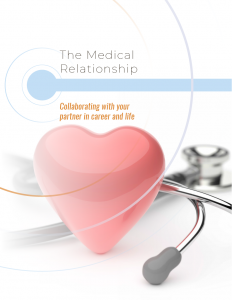Getting to Know You and Your Relationships: Cultivating Your Personal Partnerships as a Physician
The center of a physician’s job is the doctor-patient relationship. Without a healthy one, the physician is unable to help the patient make meaningful changes in their life to maintain a state of wellness. Too often, in the process of medical training, a physician’s personal relationships suffer the consequences of long hours, financial strain, and the ever-present danger of Burnout. If embracing the concept of personal Wellness is crucial as a physician, then learning how to cultivate Wellness in your inter-personal relationships is the next step in living your best post-training life.
Emotional Intelligence
Part of having any healthy relationship is treating yourself and that other person with care. One of the key skills involved in this deceptively complex task is developing Emotional Intelligence. According to Psychology Today, Emotional Intelligence (EI) is defined as “the ability to identify and manage one’s own emotions, as well as the emotions of others.”(1) By becoming more self-aware, you naturally learn to use that skill in your interactions with others, particularly those you partner with in your life. For some physicians, this comes very naturally; for others, this may be a struggle.
Most concerning is data, recently highlighted in the Journal of the American Osteopathic Association, that medical school erodes physicians’ emotional intelligence scores as physicians progress through training. (2) How does this translate into your personal life? Put simply, if physicians are barely getting by on developing that crucial doctor-patient relationship at work, we don’t have a lot left to give at home. Despite the unsettling studies, there are opportunities for change. One is to be aware of what EI is: make time to take an EQ score (3). The next step is applying what you already do with any study you order at work: know what to do with the results. Look at the Wellness resources in your workplace and ask for EI Coaching. The tools you learn here will not only improve your patient outcomes, but you’ll see the results at home as well.
Communication is Key
Now that you’re tuned into your feelings, and hopefully your partner’s feelings as well, the next step is learning the language you each communicate with. What communication looks like in your personal relationships is likely vastly different from how you give and receive information as a physician at work. From the time you enter medical training, you are schooled on the importance of communicating effectively with your patients to capture the maximum amount of data in the most efficient amount of time AND develop trust with that individual.
There are countless articles written about why this is imperative; organizations such as the American Academy of Family Physicians (4) commonly provide tips and tools sheets outlining steps such as minimizing distractions, engaging in active listening, being deliberate about non-verbal cues, and offering concrete feedback to the patient you are engaging. All of these and others are well studied, validated tools that have been shown to improve the doctor-patient relationship….so why not use these tools in the conversations that matter most: with your partner? One of the most useful tools we learn as physicians is how to adapt; why not apply these professional communication tools at home?
Have Your Eyes Wide Open
As much as we crave routine (“creatures of habit” did not become an adage because we, as humans, embrace change), we are constantly vigilant in the medical workplace for the one little thing that is “off” with our patients. Very commonly, it is that astute ability to notice the most minute change in your patient that you’ve known for years that makes or breaks a diagnosis, often leading to a life saved and a lesson learned. Just as we fall into routines in the workplace, we will do the same at home. Whether it be a childcare schedule, meal planning, or standing appointments, we are often so governed by the need to “just get it done” that we literally miss the forest through the trees in our personal relationships.
We’ve all heard the stories of spouses who are surprised when one day, their life partner presents them with divorce papers or they return home and find their partner’s belongings just gone. Physicians are not unintelligent; by definition we had to be academically successful to make it into medical school, let alone the years of school and residency.
What we often miss is the toll those years of training takes on our support system. Instead of slowly slipping into a routine that skims the surface of you and your partner’s feelings, use those keen powers of observation and really see your partner; use those active listening skills (5); watch their non-verbal responses. Ask them to do the same with you; they may not be as highly trained in this as you are, but they have the most valuable tools of all: time, longevity, and emotional investment. Keeping your eyes wide open to both you and your partner’s needs well serve you well on the next step on your journey into leading an emotionally healthy life as a physician.
To read more on medical relationships by author Amy Rakowczyk in the Career and Life Planning Guidebook for Medical Residents, follow this link: The Medical Relationship – Collaborating with your Partner in Career and Life.
Dr. Megan Vermeulen is the Director of Content Strategies at physiciancareerplanning.com and Associate Program Director at Rowan University SOM Family Medicine Residency Program.
References:
- https://www.psychologytoday.com/us/basics/emotional-intelligence
- https://www.psychologytoday.com/us/tests/personality/emotional-intelligence-test
- The Journal of the American Osteopathic Association, April 2019, Vol. 119, 236-242.
- https://www.aafp.org/dam/AAFP/documents/medical_education_residency/fmig/tips_relationships.pdf
- Jahromi, Vahid Kohpeima et al. “Active listening: The key of successful communication in hospital managers.” Electronic physician vol. 8,3 2123-8. 25 Mar. 2016, doi:10.19082/2123
Featured Physician Employer










